Wat Kalayanamitr Is The Next Spiritual Destination In Bangkok That You Cannot Miss
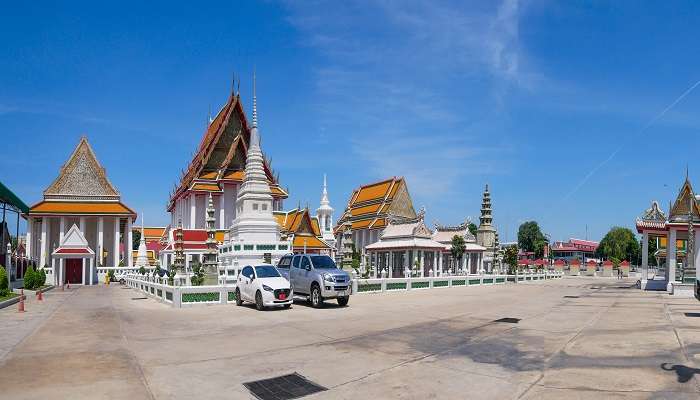
Exploring Bangkok and in search of some inner reflection? Take some time out and visit Wat Kalayanamitr. Also known as the “Temple of the True Friend,” this place of worship is west of River Chao Praya in the Thonburi district of Bangkok. Explore the depth of Thai culture, witness stunning architecture, and larger-than-life Buddha statues, and experience a sense of calmness amongst the chants and hymns of the monks and devotees. Serving as a vibrant hub for the Buddhist community, this temple invites you to immerse yourself in tranquillity amidst its hallowed grounds.
Wat Kalayanamitr Varamahavihara: History
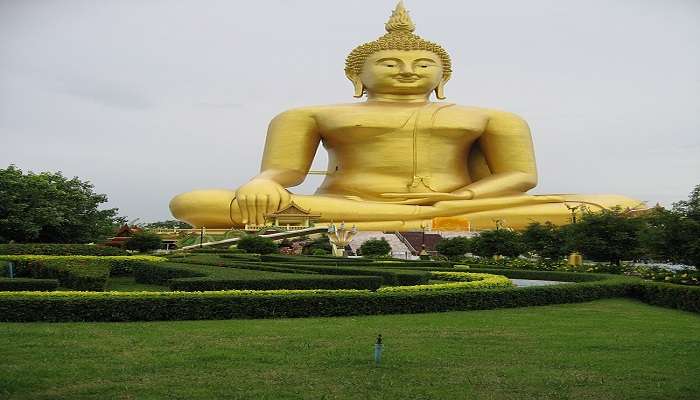
Established in 1875, Wat Kalayanamitr Varamahavihara, usually called Wat Kalayanamitr, is a second-grade royal temple built under the reign of King Rama III. Chaophraya Nikonbodin, a wealthy Thai Chinese trader and a close friend of King Rama III has donated his house and the nearby piece of his land to the temple. Legend says that when Chao Phraya NikonBodin (Toh Kalayanamitr) was awarded the title of Phraya Ratsuphawadi, the director general of Phra Suratsawadi Klang department, he donated his house and an additional piece of land for the construction of the temple and presented it to King Rama III. The king graciously named the temple Wat Kalayanamitr.
Must Read: Monasteries In Thailand
Wat Kalayanamitr: Architecture
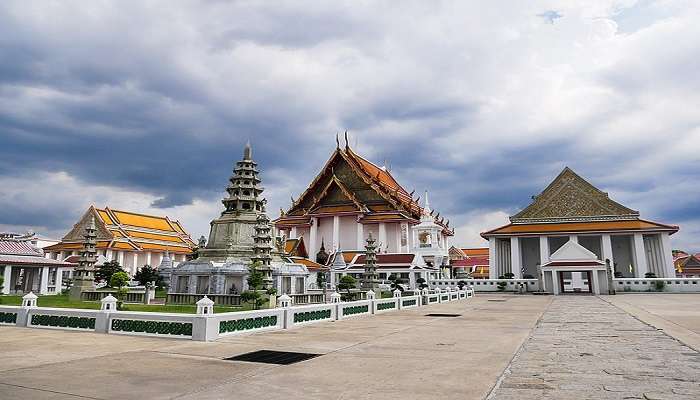
The entrance of the main shrine or vihara is studded with beautiful glass and ceramic decorations, creating a 3D effect. From the gigantic doors of the impressively large prayer halls to the walls, columns, and ceilings – adorned with vibrant murals offering insights into the preachings of Buddha, daily life routines of people from King Rama’s era, etc.- each element narrates a story showcasing Thailand’s cultural and religious heritage.
A library hall was established under the rule of King Rama IV in 1865. Known as Hor Phratham Monthian Thaloeng Phrakiat (Buddhist Book Library), this library houses Pali Canons, the teachings of Lord Buddha and many Buddhist scriptures.
Wat Kalayanamitr Varamahavihara: Subduing Mara Mudra Of Buddha
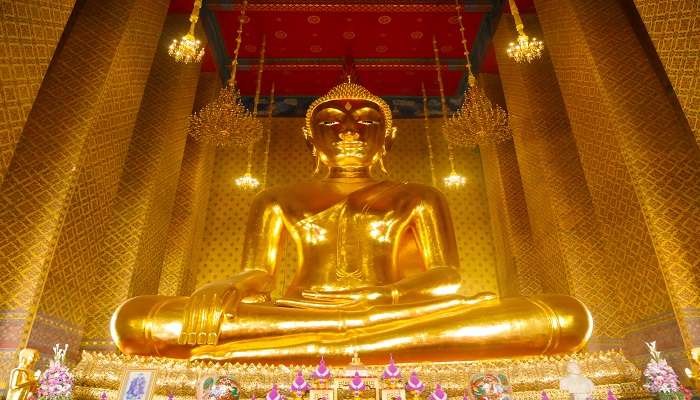
Also called “Calling the Earth to Witness,” mudra is one of the various. The Buddha statue in the main shrine or vihara is one of Bangkok’s largest seated Buddha statues measuring 12m wide and 15m tall. Made of lime and an outer layer of gold leaf, this seated Buddha with ‘Subduing Mara Mudra’ is named as Phra Buddha Trai Ratta Nayok by King Rama IV and Thai Chinese descents call it Sam Por Kong. This mudra is depicted on Seated Buddha images or statues where the legs crossed in meditation – the right hand of Buddha over the knee pointing towards Mother Earth. This posture refers to an important event in Buddha’s life history, which occurred before his enlightenment. This is the only temple in Bangkok with the principal Buddha holding the Subduing Mara Mudra posture.
Suggested Read: Holiday Homes In Thailand
Wat Kalayanamitr: Bell Tower
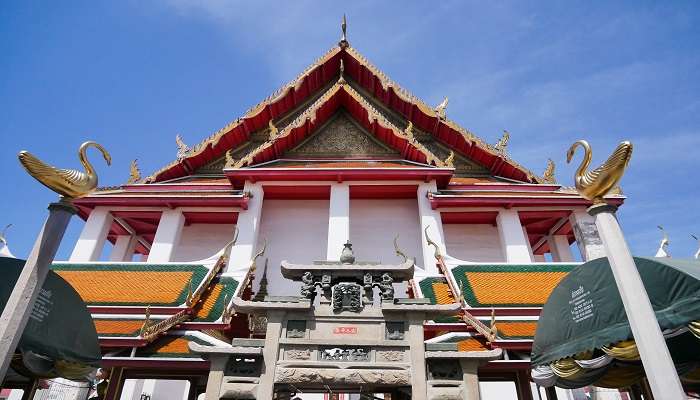
Next to the main shrine or the prayer hall is the newly constructed bell tower which holds the largest bronze bell in Bangkok, weighing 13 tons. The top of the Bell Tower pagoda consists of the Standing Buddha and the Four Heavenly Kings. Devotees and visitors approach the bell tower, make a wish and ring the bell thrice for wish fulfilment and good luck.
Wat Kalayanamitr: Prayers And Rituals
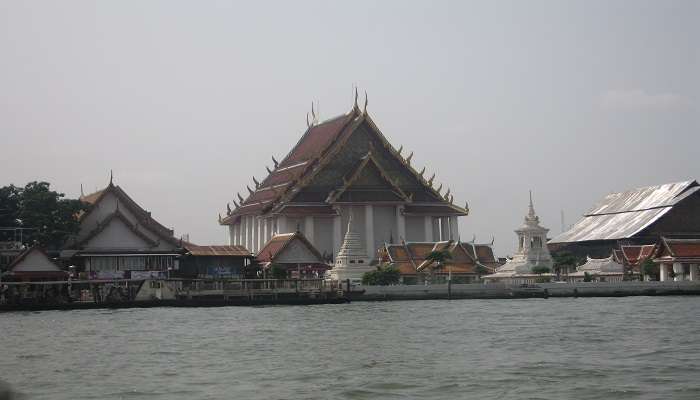
Wat Kalayanamitr is an active temple with regular chants and rituals of the monks & the locals. Quarters are allotted to the resident monks at the back of the temple. The monks here are engaged in different daily chores of the temple and do not entertain visitors. Visitors are free to visit the temple, explore the place and pay respects at the main shrine without disturbing them. Flower, fruit, and incense sticks, oil lamp offerings are carried at the Viharas. A large gong is also placed in the main shrine of the temple complex. Devotees use the gong to mark the conclusion of prayers.
Suggested Read: Ayutthaya Temples
Wat Kalayanamit Entrance Fee & Timings
The temple is open everyday from 6:30 AM to 5:00 PM, providing ample opportunity for visitors to explore its serene grounds. The absence of an entrance fee makes it accessible for all including foreign visitors.
Nearby Attractions
There are many places around to delve deeper into the city’s cultural wealth and discover the hidden gems of the city. A few are listed below:
1. Wat Prayun

Graded as a second-class royal temple, Wat Prayurawongsawat Worawihan or Wat Prayun was built in the 19th century near Memorial Bridge, Thonburi, Bangkok. Somdet Chao Phraya Borom Maha Prayurawongse, a wealthy man from an influential and noble Siamese family dedicated his own coffee estate to build this royal temple. In his honour, the temple was named “Prayun Wongsawat”. In 2018, the temple celebrated its 190th anniversary. It was recongnized by UNESCO in 2013 and got awarded Cultural Heritage Conservation Award of Excellence in the same year.
- Opening hours: 7.00 am – 6.00 pm.
- Entry fee: Free
- Distance from Wat Kalayanamitr: 1.0 km approx.
Suggested Read: National Parks in Thailand
2. Santa Cruz Church

A popular Roman Catholic Church built in 1770 by King Taksin, underwent a lot of renovations with time. The impressive structure standing now at the riverside was rebuilt in 1913 in renaissance style by a team of Italian architects. The Church was first built on site which was granted to a community of Portugese Catholics. It is located in Khwaeng (sub-district) Wat Kanlaya of the Thon-Buri district on the west bank of Chao Phraya Bank.
- Operating hours of the church: 5.00 pm – 7.00 pm.
- Entry fee: Free
- Distance from Wat Kalayanamitr: 0.5 km approx.
3. Kian Un Keng Shrine
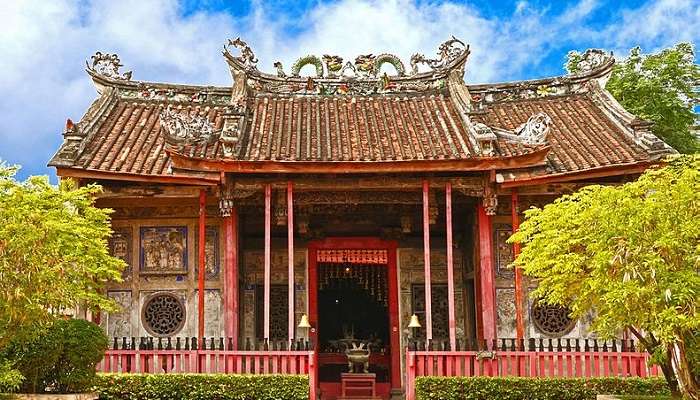
Want to visit an ancient Chinese holy place? This lesser-known gem, Kian Un Keng, is one of the oldest Hokkienese Chinese shrines founded by King Taksin. Its name means the building that brought peace and tranquil to the Hokkiens. The shrine comprises the Chinese goddess of Mercy and compassion, Guan Yin. It received ASA Architectural Conservation Award in 2008. Experience the peace at Kian Un Keng Shrine! Explore the surroundings and the narrow alleys. Don’t miss to relish your taste buds with the famous Kudeejeen cupcakes.
- Operating hours of the church: 7.00 am – 5.00 pm.
- Entry fee: Free
- Distance from Wat Kalayanamitr: less than 200m.
Further Read: Places Near Thailand
Witness the grandeur of Wat Kalayanamitr, soak in the serenity of the Viharns, surrender to the divine and seek peace. Whether you’re a sincere Buddhist or a visitor curious about Thai heritage and traditions, a visit to Wat Kalayanamitr promises a rich experience. If our comprehensive guide has inspired you, then plan trip to Bangkok today.
For our editorial codes of conduct and copyright disclaimer, please click here.
Cover Image Source: กสิณธร ราชโอรส for wikimedia Commons
Frequently Asked Questions About Wat Kalayanamitr
Is there any dress code for visiting Wat Kalayanamitr?
No specific dress codes, but visitors are encouraged to dress modestly as these are spiritual destinations.
What is the best time to visit Wat Kalayanamitr?
The best time to visit Wat Kalayanamitr is typically during the early morning or late afternoon when the crowd is less and the temperature is slightly cooler.
Is photography allowed inside Wat Kalayanamitr?
Photography is usually allowed within the temple grounds, but if you wish to click a photo of the monks be respectful and seek permission from them.
Are there any shopping spots near Wat Kalayanamitr?
Wang Lang Market and Tha Maharaj are two famous shopping spots near Wat Kalayanamitr.
How do I get to Wat Kalayanamitr?
Wat Kalayanamitr is easily accessible by various means of transportation in Bangkok, including taxi, tuk-tuk, and boat. It's situated near the Memorial Bridge, making it convenient to reach from different parts of the city.
People Also Read:
Temples In Vietnam Temples In Melbourne Temples In Sri Lanka
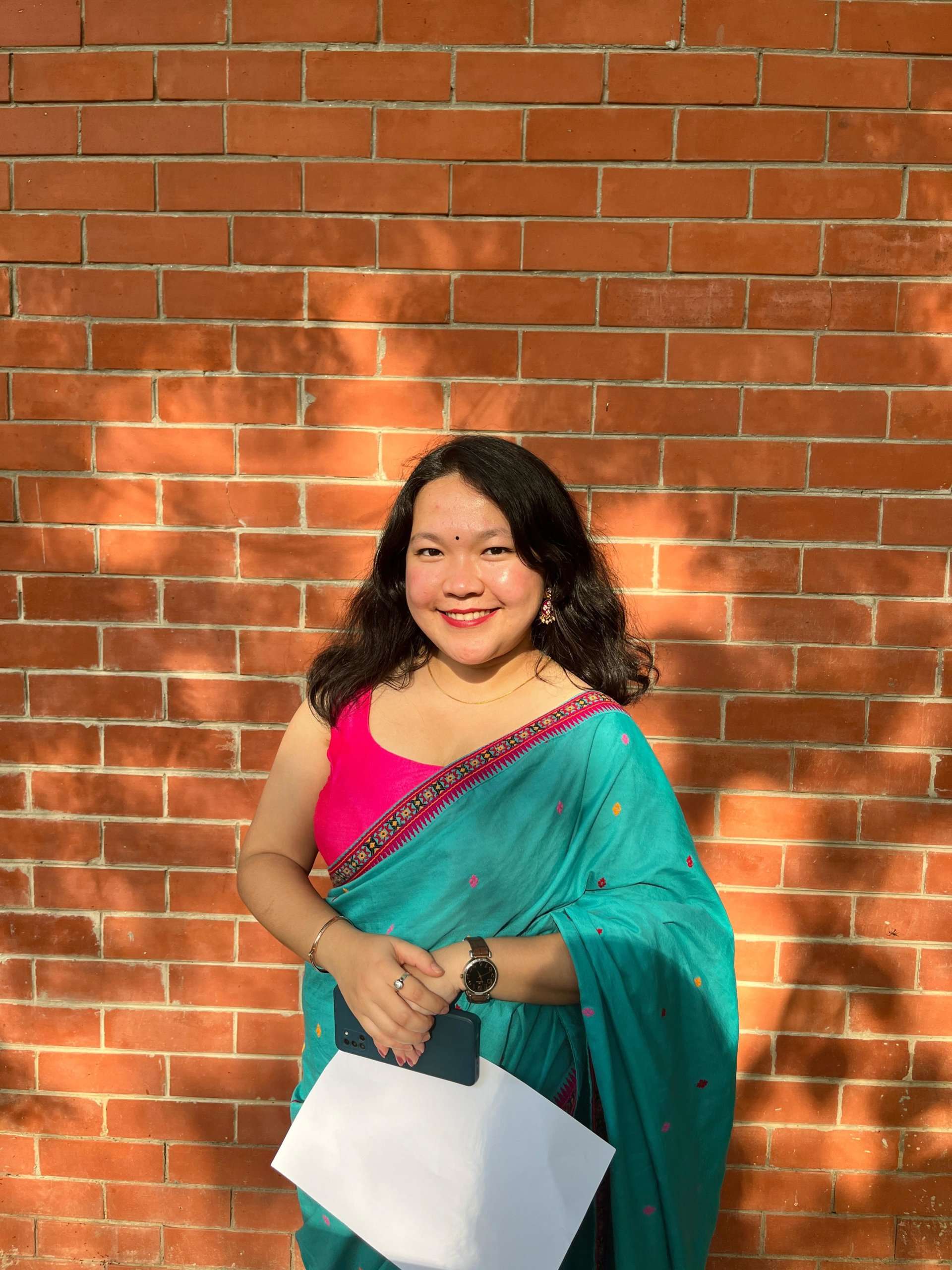
We all have to begin somewhere. This is where I start and I hope that my writings encourage you to begin. To new beginnings and conquering new places!











